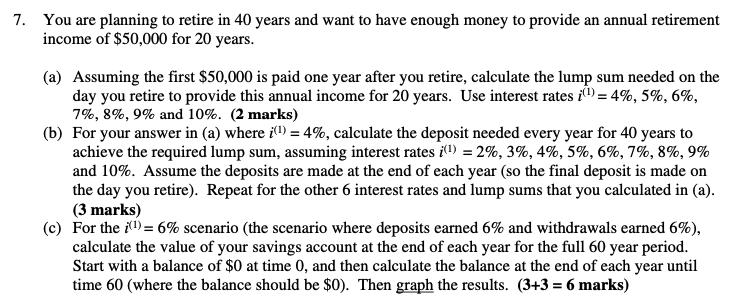
7. You are planning to retire in 40 years and want to have enough money to provide an annual retirement income of $50,000 for 20 years. (a) Assuming the first $50,000 is paid one year after you retire, calculate the lump sum needed on the day you retire to provide this annual income for 20 years. Use interest rates i(l) = 4%, 5%, 6%, 7%, 8%, 9% and 10%. (2 marks) (b) For your answer in (a) where i(1) = 4%, calculate the deposit needed every year for 40 years to achieve the required lump sum, assuming interest rates ill) = 2%, 3%, 4%, 5%, 6%, 7%, 8%, 9% and 10%. Assume the deposits are made at the end of each year (so the final deposit is made on the day you retire). Repeat for the other 6 interest rates and lump sums that you calculated in (a). (3 marks) (c) For the i(1) = 6% scenario (the scenario where deposits earned 6% and withdrawals earned 6%), calculate the value of your savings account at the end of each year for the full 60 year period. Start with a balance of $0 at time 0, and then calculate the balance at the end of each year until time 60 (where the balance should be $0). Then graph the results. (3+3 = 6 marks) 7. You are planning to retire in 40 years and want to have enough money to provide an annual retirement income of $50,000 for 20 years. (a) Assuming the first $50,000 is paid one year after you retire, calculate the lump sum needed on the day you retire to provide this annual income for 20 years. Use interest rates i(l) = 4%, 5%, 6%, 7%, 8%, 9% and 10%. (2 marks) (b) For your answer in (a) where i(1) = 4%, calculate the deposit needed every year for 40 years to achieve the required lump sum, assuming interest rates ill) = 2%, 3%, 4%, 5%, 6%, 7%, 8%, 9% and 10%. Assume the deposits are made at the end of each year (so the final deposit is made on the day you retire). Repeat for the other 6 interest rates and lump sums that you calculated in (a). (3 marks) (c) For the i(1) = 6% scenario (the scenario where deposits earned 6% and withdrawals earned 6%), calculate the value of your savings account at the end of each year for the full 60 year period. Start with a balance of $0 at time 0, and then calculate the balance at the end of each year until time 60 (where the balance should be $0). Then graph the results. (3+3 = 6 marks)







